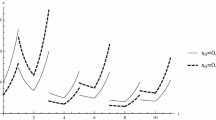Abstract
The optimal impulsive control of systems arising from linear compartment models for drug distribution in the human body is considered. A system of linear, time-invariant, homogeneous differential equations is given along with a set of continuous constraints on state and control. The object is to develop a constructive algorithm for the computation of the optimal control relative to a convex cost functional. Under suitable hypotheses, satisfying the continuous constraints is equivalent to satisfying the constraints at a finite set of abstractly definedcritical points. Once these critical points have been determined, the solution of the optimal control problem is found as the solution of an ordinary finite-dimensional convex programming problem. An iterative algorithm is given for the situation in which the critical points cannot all be determineda priori.
Similar content being viewed by others
References
Hart, H. E.,Multi-Compartment Analysis of Tracer Experiments, Annals of New York Academy of Sciences, Vol. 108, No. 1, 1963.
Rescigno, A., andSegre, G.,Drug and Tracer Kinetics, Blaisdell Publishing Company, Waltham, Massachusetts. 1966.
Jacquez, J.,Compartmental Analysis in Biology and Medicine, Elsevier Publishing Company, Amsterdam, Holland, 1972.
Bischoff, K., Dedrick, R. L., Zaharko, D. S., andLongstreth, J. A.,Methotrexate Pharmacokinetics, Journal of Pharmaceutical Sciences, Vol. 60, No. 8, 1971.
Kruger-Thiemer, E.,Formal Theory of Drug Dosage Regiments: I, Journal of Theoretical Biology, Vol. 13, No. 1, 1966.
Buell, J., Jeliffe, R., Kalaba, R., andSridhar, R.,Modern Control Theory and Optimal Drug Regimens, I: The Plateau Effect, Mathematical Biosciences, Vol. 5, Nos. 3–4, 1969.
Bellman, R. E.,Topics on Pharmacokinetics-III: Repeated Dosage and Impulse Control, Mathematical Biosciences, Vol. 12, Nos. 1–2, 1971.
Wheeler, L. A., andSheiner, L. B.,A General Method for Optimal Drug Dose Computation, Journal of Pharmacokinetics and Biopharmacetics, Vol. 4, No. 6, 1976.
Pierce, J. G., andSchumitzky, A.,Optimal Impulsive Control of Compartment Models, I: Qualitative Aspects, Journal of Optimization Theory and Applications, Vol. 18, No. 4, 1976.
Blum, E. K.,Numerical Analysis: Theory and Practice, Addison-Wesley Publishing Company, Reading, Massachusetts, 1973.
Luenberger, D. G.,Optimization by Vector Space Methods, John Wiley and Sons, New York, New York, 1969.
Coddington, E. A., andLevinson, N.,Theory of Ordinary Differential Equations, McGraw-Hill Book Company, New York, New York, 1955.
Rubinow, S. I.,Mathematical Problems in the Biological Sciences, SIAM Regional Conference Series in Applied Mathematics, No. 10, 1973.
Dieudonne, J.,Foundations of Modern Analysis, Academic Press, New York, New York, 1960.
Luenberger, D. G.,Linear and Nonlinear Programming, Addison-Wesley, Publishing Company, Reading, Massachusetts, 1973.
Author information
Authors and Affiliations
Additional information
Communicated by R. E. Kalaba
This work was supported in part by the National Science Foundation under Grant No. MPS-74-13332.
Rights and permissions
About this article
Cite this article
Pierce, J.G., Schumitzky, A. Optimal impulsive control of compartment models, II: Algorithm. J Optim Theory Appl 26, 581–599 (1978). https://doi.org/10.1007/BF00933153
Issue Date:
DOI: https://doi.org/10.1007/BF00933153



